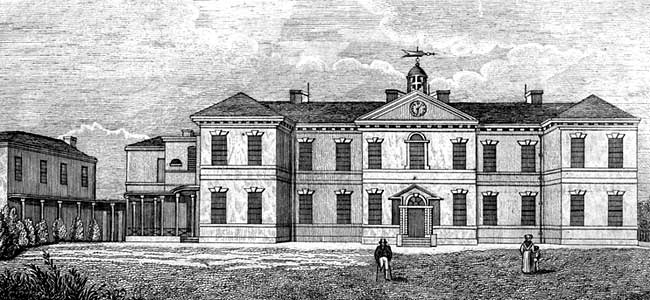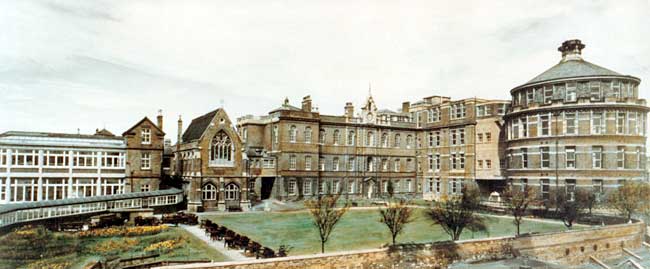
Nottingham General Hospital

The General Hospital in the 1830s.
John Key of Fulford Hall near York left a legacy of £500 to go towards erecting a County Hospital on a two acre site given by the Duke of Newcastle and the Corporation of Nottingham. John Key was the son of William Key who had come to Nottingham from Leadenham, Lincolnshire. John became a banker but retired to Fulford Hall in his later years and died in 1778. One of his sisters left a further £500 to the hospital in 1781. A further £1000 was to be found by subscriptions. This money was raised from the notable gentry, with more besides and enabled the foundation stone to be laid on 12 February 1781 amidst great pomp and ceremony. The hospital was open to the ‘sick and lame’ of any county. It was over a year later on 28 September 1782, that the hospital was opened for the admission of patients, once again amid the ringing of bells and the procession of the Mayor and the Corporation parading through the town and attending a service at St Mary’s Parish Church.
The first Annual Report in 1782 confirmed that the charity supporting the new hospital would look after the ‘sick and lame poor’. It is interesting to note that for all the rhetoric of charity towards the poor and sick there lay a touch of penny-pinching; “that (when) distressed Objects are taken into Infirmaries, for a tenth part of what must necessarily be spent for them at their own habitations..” On 26 October 1854 a foundation stone was laid by Earl Manvers (Pierrepont family) for the chapel and day ward. He was to remain an active supporter and friend of the hospital until it became a state hospital. For quite some years of the hospital’s existence the ‘Anniversary Meetings’ were occasions of great splendour; church services followed by somewhat lavish banquets.
Patients were only accepted into the hospital if they were… ‘clean as may be, and with a proper change of linen’ and with a recommendatory letter, signed by a subscriber (to the hospital funds). He or she was to bring with them also a short statement of hi/her case and attend on a Tuesday morning. He would be examined by the surgeon and the receiving physician who would report on their suitability to the Weekly Board. If this was not enough the patient then had to have the Rules of the Hospital read to him and to conform to the directions of the physician and surgeon and to obey matron and to receive no provisions, liquors or medicines from the outside and any misbehaviour would result in them being discharged for irregularity and would be unable for future admissions! The book ‘A history of the General Hospital near Nottingham’ goes into great depth as to admissions, apparatus used, staff and diets of the hospital during the first 50 years of the hospital.
Many people who have had the misfortune to be a patient at the General Hospital, Nottingham will know the names of wards such as Storer and Attenburrow. These were named after Dr John Storer who came to Nottingham in May 1781 and was the much honoured leader of the medical profession. He had taken an active part in founding the General Hospital, the Sneinton Lunatic Asylum, the Vaccine Institution and Bromley House Library. He retired from the General Hospital in 1802. John Attenburrow was surgeon to the hospital for 61 years from 1782 until 1843. He was a keen follower of Jenner’s vaccination discovery and introduced vaccination in Nottingham in 1800.
In March 1877 a foundation stone was laid for a new wing by the Rev. Canon Morse which would provide extra room for 45 patients at a cost of £12,000 and despite the continued concern at the budget, it was felt that the cost to people being turned away was even greater. The wing was opened in October 1879 and much of its design was owed to Dr W H Ransom, who had been physician to the General Hospital since 1854. He had retired in 1890 and died in 1907.
Christmas was celebrated in style in the hospital in 1885 with not only the nurses and patients decorating the wards with gifts from Lord Middleton, Col. Seeley, MP, Miss Hawksley of Bunney, and other subscribers giving their services to enliven the stay of the patients. Dinner was roast beef and plum pudding and the arrival of the Christmas tree, donated by Mrs Webb of Newstead Abbey.
When the hospital had first been built inmates had an uninterrupted view of the Castle but in the ensuing years land had been sold for premium housing with a veto on factories being built on the land. Some of the houses that had been built in the area near the hospital had been purchased for extensions to the hospital. At the end of the nineteenth century with the resignation of Rev Henry Seymour, governor of the hospital and chairman of the Monthly Board, Sir Charles Seeley was asked to take his place which he readily did so and devoted his great ability and energy to the welfare of the hospital.
He was then elected as Chairman of the Extension Committee in 1897 and along with other members visited Liverpool to see the circular wards of their hospital. With the appointment of the famous London architect, Mr A Waterhouse, RA the new wing, known as the Jubilee Wing (after Victoria’s Diamond Jubilee) was built and completed in 1900. It comprised circular ward, a service block and a sanitary block; the main circular building had five stories. The wing was not only well designed it was a handsome addition to the hospital. The editor of The British Journal of Nursing described its transformation from a one-block handsome and red brick mansion into a stately and comprehensive hospital. She went on …”we enter a lovely room, arched in the centre, decorated in green and white with polished floor, on which are mellowed Persian rugs and finely carved oak furniture ... Admiration is expressed for the newly-finished Nurses’ Homes, the gift of Sir Charles.”
Many more improvements and extensions were carried out thanks to Sir Charles. In 1902 he made a gift of the old Children’s Hospital which was just across from the General Hospital on Postern Street and its entrance faced the old entrance to the General Hospital. The old Children’s Hospital was to take the place of the old iron Isolation Hut and a bridge was built over the road for convenient communication. In 1911 he donated two houses on the south side of the hospital grounds for the use by consumptives and housed 24 beds until the end of the First World War.
Due to deteriorating health Sir Charles resigned from his role at the hospital in 1914 and died at his home in the Isle of Wight in 1915. During the First World War the hospital was set up to take injured soldiers both in the hospital as well as an adjacent house loaned by Henry Thornton. The Red Cross Society provided much of the equipment as well as nursing staff. As the war progressed temporary buildings to accommodate 150 beds were set up on the lawn in front of the hospital; donations towards these were made by W G Player and Thomas Forman. The numbers of soldiers being treated at the hospital rose from 66 to 203 over the four years. The number of staff at the hospital was greatly affected by those either called up or going voluntarily to the Front. This allowed women doctors to play a more significant role in the hospital. At the end of the war the 1919 Influenza epidemic hit the city and although there were cases of the nursing staff contracting influenza there were no deaths.
After the war a special committee was set up to deal with the both an extension and reconstruction of the hospital. With money donated and a subscription fund as well as a grand bazaar around £100,000 was raised. The new building was opened by HRH Prince of Wales on 1 August 1923. Within the ‘new’ hospital it was decided to establish an ear, nose and throat department and despite initially poor accommodation the department was located at the new Ropewalk Wing which provided much better facilities. Unfortunately a proposed department for venereal diseases was shelved. In 1923 the huts on the lawn were demolished and removed leaving the lawns restored to their original beauty. The dispensary was in the care of the apothecary (in 1815 the Apothecaries’ Act was passed which stated that no one should practice as an apothecary without qualifications) who responsible for dispensing medicines. In 1927 the original premises became inadequate and a new dispensary was provided in the new Ropewalk Wing under the guidance of Miss Francis Prince.
The reason why the General Hospital was regarded in such high esteem was due primarily to the fact that it had so many powerful, generous and zealous friends.
During the inter-war years work began on the Ropewalk Wing on the road opposite the entrance to the General Hospital. The land was provided by the Corporation of Nottingham. New facilities were planned for out-patient and casualty departments, as well as ear, nose and throat and X-ray department and a physiotherapy department. A new children’s ward was established on top of the Jubilee Wing and named Mabel Player ward. One of the hospital’s greatest supporters, Sir Jesse Boot died in 1931; his association with the hospital was long and had benefitted the hospital in monetary terms of over £50,000. During these years funds were raised for equipping the wards from a variety of sources and it is interesting how much they were able to raise given the austere time during the wars.
During the Second World War the hospital was fortunate that it did not take a direct hit during the air raid of 8 May 1941, several bombs landed nearby and 73 people were admitted suffering from injuries, burns and shock. Life continued within the hospital without too much disruption; convoys bringing injured soldiers always arrived during the night but were welcomed by Defence Forces offering hot drinks and taken to the main Hall, the number of admissions averaged 100-150. During this time the Player family continued to donate money for the construction of new wards.
In 1947, two years after the end of the war the hospital celebrated its 165th anniversary and its last year as a Voluntary Hospital. In those 165 years medicine had progressed almost beyond imagination; the sulphonamides to conquer wound infection and control of pneumonia; surgery was now going even deeper into the body and preventative medicine were three of the most important aspects of the hospital.

Nottingham General Hospital, c.1980.
The hospital continued to be a central part of the life of Nottingham but by the 1960s it became obvious that the hospital requirements were growing and the capacity of the General Hospital, despite numerous extensions and take overs of other buildings, could not keep up with the pressure. It was decided that a new hospital should be built to accommodate the growing requirements of a modern teaching hospital. It was to take another decade before the replacement, Queen’s Medical Centre, was finally built and opened by HM The Queen in July 1977. Much of the old General Hospital has been turned into private accommodation and a restaurant. Some buildings in the Ropewalk Wing are still used by the NHS.